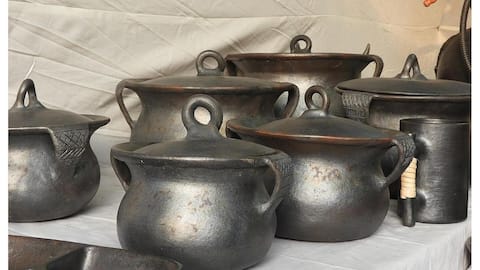Exploring the primordial Longpi pottery
What's the story
Longpi pottery, a treasure originating from the serene village of Longpi situated in Manipur, holds a special place in the hearts of art lovers. Its timeless elegance and intricate craftsmanship have captivated people from all walks of life. Let us delve into Longpi pottery's origins, delicate techniques, skills, and some facts that define this beloved art form from Manipur.
Black stone pottery
Longpi Ham
This unique form of black stone pottery, known locally as Longpi Ham distinguishes itself by its craftsmen's avoidance of the traditional pottery wheel. Longpi pottery is crafted from a blend of ground black serpentinite stone and distinctive brown clay native solely to Longpi village and encompasses a diverse range of items including pots, pans, vases, and various other articles.
Royal rituals
Cultural significance
In the past, Longpi pots served as essential cooking utensils for the Tangkhul Naga tribe until aluminum pots became widespread. Today, Longpi pottery is not only utilized for cooking but also for storing food and beverages. With its unique black sheen and rustic matte texture, this Manipuri pottery holds deep historical importance. Longpi vessels were reserved for royal rituals, religious ceremonies, and significant gatherings.
Making process
Rolling and burnishing
Longpi pottery begins by blending locally sourced clay with "weathered rock" or "serpentinite" clay in a 3:1 ratio. The clay mixture is then hand-rolled into thin ropes, coiled to shape the pottery, and carefully smoothed by hand for the final form. After shaping, the pottery undergoes burnishing with a smooth river stone, enhancing its unique finish and durability. It is then left to dry.
Baking
Kiln and polishing
After drying, Longpi pottery is fired in a traditional wood-fired kiln, a process lasting several hours. Subject to high temperatures, the serpentinite in the clay mixture interacts with the heat, resulting in the pottery's iconic black hue. Meticulous post-firing treatments involve using locally sourced river stones and macha leaves, well-known for their fine texture, to refine the surface and add a sheen.
Some facts
Seasoning
Before initial use, it is crucial to season Longpi pottery to safeguard and enrich its natural finish. To season, gently rub the pottery's surface with cooking oil like vegetable or sesame oil. Next, heat it over a low flame for a few minutes to create a non-stick surface.When cooking with Longpi pottery, it is vital to employ low to medium heat to prevent cracking.
Curries
Great for simmering
Longpi pottery is great for cooking a variety of dishes, such as stews, curries, and soups. Longpi pots are ideal for simmering and slow cooking over a low flame, allowing the flavors of the ingredients to develop fully. The black color is obtained naturally, without any chemicals or paints. Since the entire process is handmade, the craft generates employment opportunities in rural areas.
